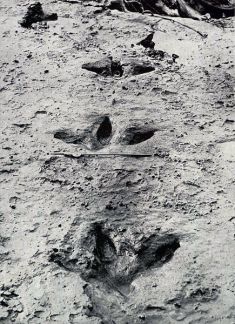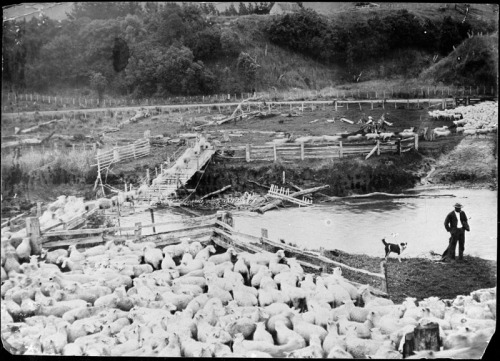
It’s been a bit quiet on the blogging front lately, as I have been busy getting as much writing done on my book as I can before the Claude McCarthy Fellowship I was so fortunate to receive finishes. The book examines the environmental history of the Manawatu Region, in the lower North Island of New Zealand, from pre-history through to today (see: Manawatu’s environmental past to be documented), and I have been working on it (between work, family and life) for a couple of years now. (See: A racy title is one thing, but what’s the book actually about? for a synopsis of the book.)
Making progress on writing has been further challenged by the arrival earlier this year of our baby girl, Caitlyn. Caitlyn is known to make her feelings very clear when I spend too much time staring at the screen of my laptop, rather than gazing at/playing with/talking to her. (Her protests are in fact entirely justified – she is a little charmer, and it would not be inconceivable to spend every waking hour gazing at/playing with/talking to her, though sadly this is not possible.)
Anyway, thankfully, I seem to have broken the back of the writing, and am now working on the final chapters of the book. In between writing, I have been sending off book proposals to the ever-shrinking pool of potential publishers, and … waiting … More of this later, but in the process of trying my resolute best to sell the book to prospective publishers, I have been very conscious of the title. Though I have had a working title for some time, I have not been completely satisfied that it does enough to interest or excite, and not being a particularly creative type, I would really appreciate some ideas from people more imaginative and creative than me (for the record, I can guarantee that will be most of you).
So, here is a list of the titles I have come up with, with notes below: (You can vote for your favourite title, or offer another here)
1. From Forested Hinterland to Pastoral Province: An Environmental History of the Manawatu
2. Environment or Economy? An Environmental History of the Manawatu
3. Beyond the Bucolic: An Environmental History of the Manawatu
4. Live by the Sward, Die by the Sward: An Environmental History of the Manawatu
5. In the Moa’s Footprints: An Environmental History of the Manawatu

Notes on 1) this has been the working title. It accurately and quite clearly describes the transformation of the region, which is good, but it also a bit plodding and predictable. Lots of local histories use this pattern, “From xxx to xxx …” and I worry I may therefore be detracting from the distinctiveness of the book.
2) This one kind of sums up the “eternal dilemma”that has characterised the environmental history, and pretty much every environmental history the world over, but that it probably its problem – that it isn’t distinctive enough. But also, its BORING.
3) Refers to the layers of history behind the pastoral landscape that characterises most of the Manawatu today. It’s OK, though some might (unkindly I feel) argue that the Manawatu is not very bucolic!
4) This is me trying to be funny. As far as I know, no people have died as a result of growing grass in the Manawatu – directly, anyway – but some might argue that the environment – especially the indigenous – has. Not really a serious contender, I don’t think, but I thought only have four options was a bit measly.
5) This is my current favourite – everyone is intrigued by moa! – but needs explaining. Explanation: it refers to the discovery of a set of large moa footprints in the Manawatū riverbank, following a flood in 1912. By chance, these footprints had been perfectly preserved in a layer of hardened blue clay, revealed when the layers of sand and soil above were scoured away by the powerful floodwaters. The discovery made national headlines, and excited scientists and the general public alike. This event is significant not only because it vividly demonstrates the powerful force of the river in shaping the Manawatū and its history, but also because it shows how layers of environmental history are found behind every landscape. (See: Prehistoric revelations of a Manawatu flood)
I would really like to know whether you like any of these titles – or if not, can you think of a better one? Please let me know if you have any ideas. The submitter of the winning title will get you a copy of the book! …
Though there is that small matter of getting it published first …

Looks like it will be an interesting read. What about ‘A landscape changed – An environmental history of the Manawatu.’
What about ‘How Little Bo Peep’s Sheep Moved To The Manawatu Because The Grass Was Greener, and There Were No Trees For The Wolves To Hide In.’
Thanks Ukelele4kids – Inexplicably, I seem to have overlooked Little Bo Peep’s sheep and their role in shaping the Manawatu environment. I wonder, were they Lincoln or Romney Marsh? Or Leicester perhaps?
Feedback from Twittersphere:
@DollyJorgensen: I like the moa option, particularly if you weave the idea of environmental footprints throughout & tell moa story in intro.
Thanks Dolly, envirohistory NZ
I too like the reference to Moa in the title. Their browsing behaviour in connection to postural Manawatu is a pleasing connection ( for me).
Thank you Raina, really appreciate your feedback. Cheers, envirohistory NZ
I like the moa one best too. I think the Maori names are so poetic: I never knew Manawatu translates as “Heart standing still” in english. Could be an alternative..
Thank you Nick, really appreciate your thoughts – yes, actually, there are different interpretations of the name Manawatu and how the river got it. You will have to read the book to find out more! 😉
And, by the way, I like the idea of the Maori translation being used somehow – I have been thinking about that too. Thanks again for your thoughts.
let me be the devils advocate…
ad 1. solid but as you mention a bit predictable.
ad 2. a oversimplified dichotomy esp. for env hist book.
ad 3. nice word, but if people do not identify it with the region and there is no story or quote behind it it nothing more than that.
ad 4. biblical quote are always difficult. in this instance the sward didn’t take any “revenge” and no farmer were ploughed under or uprooted.
ad 5.The Moa is the NZ Dodo. Following the moas footsteps doesn’t seem to promising except you want to imply a certain direction of the development, which I don’t think you do. Even if the metaphore of the palimpsest is nice, it will not be understood from the title alone and there isn’t much to learn from these footprints about the Manawatu.
my 2 c.
Thank you Markus for your very thoughtful response. Yes, as far as I know, there are no instances of swards of grass rising up and taking revenge on a farmer … a kind of “Triffids Downunder” story? Though, interestingly, there were instances of the almost universal use of the rye and clover “duo-culture”, as they call, it causing illness – even death – in cattle, and so I guess that is kind of “dying by the sward” in a vicarious sort of way … But having said all that, that phenomenon was not limited just to the Manawatu, it was a national problem.
I like the Moa reference too, but as a title it might be more beguiling with a word like ‘Beyond’ rather than In, implying a more positive outcome!
Thank you Tessa, yes that was a good point made by Markus too.
A vote from over the sea… I’d go for the Moa’s Footsteps… But perhaps consider deleting the introductory ‘in’, so is just ‘The Moa’s Footsteps…’, sounds more mysterious 🙂 Best wishes attracting a publisher.
Thank you for your suggestions, Ian – really appreciate it. Thanks for the good wishes attracting a publisher too! (I need everything I can get!) You have a great ecological research website @ ianluntecology.com, by the way.
Hi Catherine
Seems you are doing well with family, a book to be published, … which is nice to hear. How about:
Environmental History of the Manawatu
Subtitle:
From Moas, the human pursuit of economic progress and the limitations of the natural environment
Or shorter at the end: … environmental limits
Greetings,
Karlheinz 😉
Hi Karlheinz – So nice to hear from you! Many thanks for the ideas. 🙂
From LinkedIn environmental history discussion board: To me it seems the most appropriate title From Forested Hinterland to Pastoral Province. By Hrvoje Petrić
– Many thanks, Hrvoje from envirohistory NZ
Can’t resist adding my two cents. Until you have a publisher you can use whatever working title you like. In my experience however, publishers are grateful to authors who provide thoughtful and interesting narratives. Titles and cover images though are their primary marketing tool, something too important to leave to an author. You have some key words and concepts, find some arresting imagery (you have to buy this book kind of things) and send them along. Working with a decent can be a lot of fun but you have play nicely and share.
Cheers,
David
Good advice, thanks David. Thank you for sharing your experience. Your last statement – “Working with a decent …” Is there a word missing?
ops, “editor” should have been in there.
I prefer the moa idea, too, Catherine, and I second Ian’s suggestion to omit ‘In’ — ‘In the Moa’s Footprints’ sounds a little pedestrian ;^). Another option might be something like ‘From Moa to Mower’, but I’m equivocal about that because a lot of people would misinterpret ‘moa’ and ‘mower’ as homonyms, which they’re not. ‘Moa and More’ would get around that, but I’m not sure it’s focused enough, even with the second part of the title.
In short, I think the moa idea warrants further thought. However, as David points out, you’ll almost certainly have to defer to the publisher.
Thanks for your thoughtful response Pete. “From moa to mower” is rather ingenious – the difficulty is finding something that is appealing and punchy, but which also alludes to the distinctiveness of the Manawatu.